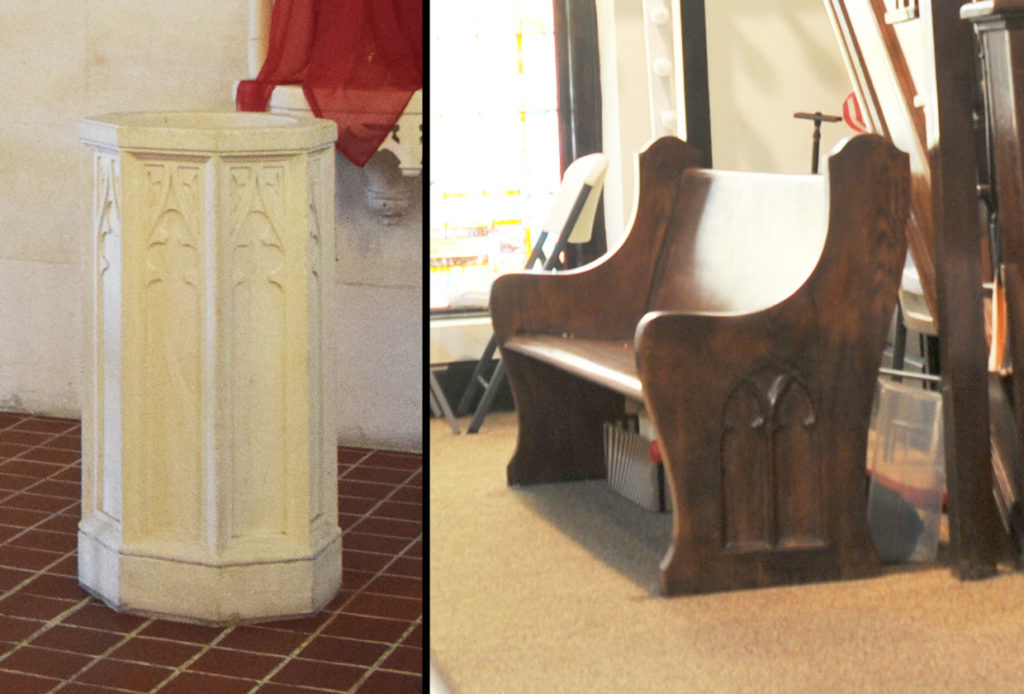Resilience Treatments & Strategies
Furniture

Description
Any movable objects designed to support objects or activities. Many historic furniture pieces are artistically or culturally significant and can be hard to replace if damaged by a disaster. There should be an evacuation plan for small pieces of significant furniture. Large pieces (e.g., baptismal fonts or carved pews) should be affixed to the floor when preparing for an imminent disaster to prevent them from being broken apart by rising and receding floodwaters.
Typical Damages from Floods or Hurricanes
- Unsecured furniture can become dislodged and thrown about in a flood, possibly breaking up
- Secured or especially heavy furniture is likely to be submerged for an extended period of time in a flood, possibly swelling or distorting if made of wood
- Musical instruments that have become waterlogged are typically damaged to the extent that restoration would cost as much or more than replacement (organs can be an exception)
Other common conditions contributing to vulnerability towards floods or hurricanes
- Lack of emergency, disaster response, or salvage plan
- Lack of space or ability to relocate delicate or precious items to a safe location prior to a storm
Resilience Treatments and Strategies
The THC offers resources and provides links for more information on salvage and recovery of cultural artifacts [https://www.thc.texas.gov/preserve/projects-and-programs/museum-assistance/additional-resources]
In-house
Inventory and map culturally significant pieces of furniture and include in the disaster response and recovery plan. With a plan in hand, first responders will know what to expect when they enter a building and may be able to protect or salvage culturally significant heritage.
Prior to a major storm, temporarily anchor light objects, if necessary to prevent them from floating away, or move them to higher storage areas (attic or upper floors).
During salvage operations, isolate furniture that exhibits mold growth from other objects that could succumb to it spreading (may need a disaster recovery professional if multiple objects are affected). Save all pieces of furniture possible even when waterlogged and distorted as restoration may be possible.
Professional needed [type]
- Repair, reassemble, or otherwise restore furniture [conservator or skilled craft technician]. If all of the objects are damaged, the professional/technician may need photos or drawings for reference to restore in-kind.
Furniture

Description
Any movable objects designed to support objects or activities. Many historic furniture pieces are artistically or culturally significant and can be hard to replace if damaged by a disaster. There should be an evacuation plan for small pieces of significant furniture. Large pieces (e.g., baptismal fonts or carved pews) should be affixed to the floor when preparing for an imminent disaster to prevent them from being broken apart by rising and receding floodwaters.
Typical Damages from Floods or Hurricanes
- Unsecured furniture can become dislodged and thrown about in a flood, possibly breaking up
- Secured or especially heavy furniture is likely to be submerged for an extended period of time in a flood, possibly swelling or distorting if made of wood
- Musical instruments that have become waterlogged are typically damaged to the extent that restoration would cost as much or more than replacement (organs can be an exception)
Other common conditions contributing to vulnerability towards floods or hurricanes
- Lack of emergency, disaster response, or salvage plan
- Lack of space or ability to relocate delicate or precious items to a safe location prior to a storm
Resilience Treatments and Strategies
The THC offers resources and provides links for more information on salvage and recovery of cultural artifacts [https://www.thc.texas.gov/preserve/projects-and-programs/museum-assistance/additional-resources]
In-house
Inventory and map culturally significant pieces of furniture and include in the disaster response and recovery plan. With a plan in hand, first responders will know what to expect when they enter a building and may be able to protect or salvage culturally significant heritage.
Prior to a major storm, temporarily anchor light objects, if necessary to prevent them from floating away, or move them to higher storage areas (attic or upper floors).
During salvage operations, isolate furniture that exhibits mold growth from other objects that could succumb to it spreading (may need a disaster recovery professional if multiple objects are affected). Save all pieces of furniture possible even when waterlogged and distorted as restoration may be possible.
Professional needed [type]
- Repair, reassemble, or otherwise restore furniture [conservator or skilled craft technician]. If all of the objects are damaged, the professional/technician may need photos or drawings for reference to restore in-kind.